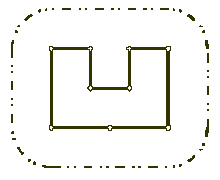POJ 1113 Wall
做完2187之后这1113立马简单了啊。
题目大意:
给出一个多边形(不一定是凸多边形),求围住这个多边形且离多边形上每一点的最小距离是L的多边形的距离。

解题思路:
其实看这个题目中的图就能够明白这个题该怎么计算了。
1、先求这个多边形的凸包(用的Graham扫描法)。
2、求凸包上相邻点之间的距离。这样所有直的墙面的长度就求出来了。
3、再加上2*pi*L。因为所有转角角度之和一定是360度,所以要加一个圆的周长。
下面是代码:
#include <stdio.h>
#include <stdlib.h>
#include <math.h>
struct node
{
int x,y;
} point[1005],conhull[1005];
int cmp(const void *a,const void *b)
{
struct node *aa=(struct node *)a;
struct node *bb=(struct node *)b;
if(aa->y==bb->y)return aa->x-bb->x;
return aa->y-bb->y;
}
int n,cnt;
int xmult(node a,node b,node c)
{
return (a.x-c.x)*(b.y-c.y)-(b.x-c.x)*(a.y-c.y);
}
void Graham()
{
qsort(point,n,sizeof(point[0]),cmp);
conhull[0]=point[0];
conhull[1]=point[1];
cnt=2;
for(int i=2; i<n; i++)
{
while(cnt>1&&xmult(conhull[cnt-1],point[i],conhull[cnt-2])<=0)
{
cnt--;
}
conhull[cnt]=point[i];
cnt++;
}
int min1=cnt;
for(int i=n-2; i>=0; i--)
{
while(cnt>min1&&xmult(conhull[cnt-1],point[i],conhull[cnt-2])<=0)
{
cnt--;
}
conhull[cnt]=point[i];
cnt++;
}
}
double dist(node a,node b)
{
return sqrt((double)((b.x-a.x)*(b.x-a.x)+(b.y-a.y)*(b.y-a.y)));
}
int main()
{
int l;
double sum=0;
scanf("%d%d",&n,&l);
for(int i=0; i<n; i++)
{
scanf("%d%d",&point[i].x,&point[i].y);
}
Graham();
for(int i=0; i<cnt-1; i++)
{
sum+=dist(conhull[i],conhull[i+1]);
}
sum+=2*3.141592654*l;
printf("%.0f\n",sum);
return 0;
}


